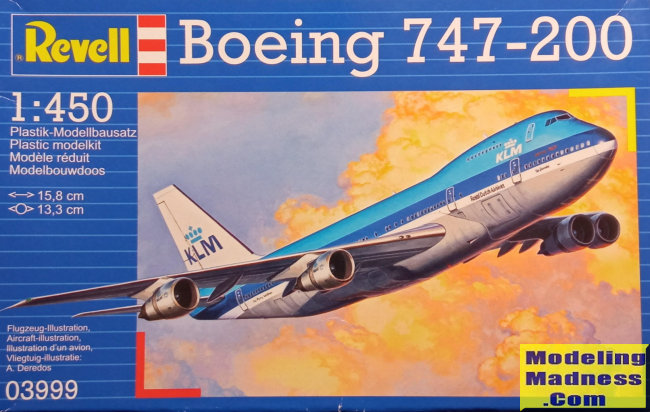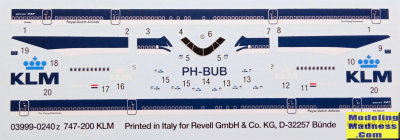
| KIT #: | 03999 |
| PRICE: | $6.00 |
| DECALS: | One option |
| REVIEWER: | Spiros Pendedekas |
| NOTES: | 1974 Heller tooling |

| HISTORY |
The Boeing 747 is a large, four-engined, long-range
wide-body airliner manufactured between 1968 and 2023.The first flight took
place on February 9, 1969, earning certification in December of that year.
Entering service with Pan Am on January 22, 1970, the rest is history. It was
the first airplane called a "Jumbo Jet" as the first wide-body airliner.
With a ten-abreast economy seating, it typically accommodates 366 passengers in
three travel classes. It has a pronounced 37.5° wing sweep, easily allowing a
Mach 0.85 cruise speed. Its heavy weight is distinctively supported by four main
landing gear legs, each with a four-wheel bogie. The partial double-deck
aircraft was designed with a raised cockpit so it could be converted to a
freighter airplane by installing a front cargo door, as it was initially thought
that it would eventually be superseded by supersonic transports.
A total of 1,574 (including prototype) have been built.
| THE KIT |
 This
kit was first manufactured by Heller in 1974, then reboxed another nine times
from Heller itself, Lodella, Blue Ribbon Collectors Series (lovelily bagged,
just like old times) and Revell (in two versions, “standalone” and “Model Set”,
the latter including paints, glue and paintbrush). The specific kit is the
Revell “standalone” version, bought for a mere $6 from a vendor during a model
show/contest that took place in March 2023 in my hometown, Chalkis, Greece.
This
kit was first manufactured by Heller in 1974, then reboxed another nine times
from Heller itself, Lodella, Blue Ribbon Collectors Series (lovelily bagged,
just like old times) and Revell (in two versions, “standalone” and “Model Set”,
the latter including paints, glue and paintbrush). The specific kit is the
Revell “standalone” version, bought for a mere $6 from a vendor during a model
show/contest that took place in March 2023 in my hometown, Chalkis, Greece.
The kit comes in a small side opening “Revell style” blue box of good quality,
carrying a nice box art of a KLM 747. Upon opening the box, I was greeted with
22 white styrene pieces, arranged in two equally sized sprues. Molding is
definitely old school, with raised panel lines that are vastly off scale (in
fact, given the minuscule 1/450 scale, maybe totally sanding away panel lines
may seem more “correct”). A good amount of flash is evident and will have to be
cleaned off.
Apart from the main parts’ seemingly correct general shapes, there are no other
details to speak of. The engines are very simplified, not even featuring a
hollowed compressor face. Landing gear is absolutely toy-ish and there are
neither wheel bays nor doors. Of course, most of the above “simplifications” can
be somehow justified by the kit’s small scale and mold origins.
There are no transparencies to speak off, all glazing having to be replicated by
decals. Instructions come in the form of a double folded A2 paper, featuring a
short history of the type, a parts diagram, with the simple construction spread
in 6 very clear steps.
 Only one,
very charming KLM scheme is provided, with two alternate registrations. Colors
are given in Revell codes, but also in generic form. Decals are superbly
printed, presumably by Cartograf, promising to significantly boost the looks of
the completed model.
Only one,
very charming KLM scheme is provided, with two alternate registrations. Colors
are given in Revell codes, but also in generic form. Decals are superbly
printed, presumably by Cartograf, promising to significantly boost the looks of
the completed model.
Instructions want you to first join the fuselage halves, trapping 5 grams of
weight in the nose, then assemble and attach the aerodynamic surfaces, engines
and wheels, ending a build that could not be simpler.
Considering the Lilliputian 1/450 scale, maybe sanding off all panel lines might
produce a more scale-correct effect. In addition, totally omitting the landing
gear and filling the holes, going for a gear-up configuration might also
contribute to departing from the kits toy-ish looks, only leaving the very
simplified engine faces compromising the image.
| CONCLUSIONS |
April 2023 Copyright
ModelingMadness.com. All rights reserved. No reproduction in part or in whole
without express permission. If you would like your product reviewed fairly and fairly quickly, please
contact
the editor or see other details in the
Note to
Contributors.